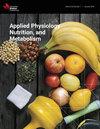Supplementation practices among pregnant women and those trying to conceive: a population-representative survey in Vancouver, Canada
IF 2
4区 医学
Q3 NUTRITION & DIETETICS
引用次数: 0
Abstract
Applied Physiology, Nutrition, and Metabolism, Ahead of Print.Dietary supplements including vitamins, minerals, and natural health products are commonly consumed by those aiming to optimize fertility and pregnancy outcomes. The aim of this survey was to describe supplementation practices among individuals who were pregnant or trying to conceive in Vancouver, Canada. An online survey was conducted among 500 individuals who were pregnant (n = 250) or trying to conceive (n = 250). Participants met a substantial proportion of vitamin and mineral recommendations through supplements alone. Exceptions included calcium, magnesium, and choline, with median (interquartile range (IQR)) supplementation doses reported by those who were pregnant and trying to conceive, respectively, of: 250 (200 and 250 mg) and 250 (200 and 250 mg), 50 (50 and 75 mg) and 50 (50 and 90 mg), and 53 (10 and 150 mg) and 55 (10 and 100 mg), as compared to perinatal recommendations of 1000 mg/day (calcium), 350 mg/day (magnesium), and 450 mg/day (choline). Conversely, median (IQR) doses of folate reported by those who were pregnant and trying to conceive, respectively, were: 1000 (780 and 1000 µg) and 1000 (800 and 1000 µg), with ∼70% overall (337/471) reporting doses ≥1000 µg (the tolerable upper intake level). Most participants (451/500; 90%) reported supplementation with a prenatal multivitamin; of these, 83% reported that supplementation occurred daily. Overall, as diet was not considered, we cannot ascertain whether recommendations for calcium, magnesium, and choline were met through the combination of supplements and foods; however, we believe that additional supplementation with choline may be required to meet recommendations in pregnancy. Excessive folate supplementation has been previously identified as a concern throughout North America; here, we provide further evidence for excessively high doses consumed via supplements.
孕妇和试图怀孕者补充营养的做法:加拿大温哥华一项具有人口代表性的调查
应用生理学、营养学和新陈代谢》(Applied Physiology, Nutrition, and Metabolism, Ahead of Print)。 膳食补充剂包括维生素、矿物质和天然保健品,是那些旨在优化生育和妊娠结果的人常用的补充剂。这项调查的目的是了解加拿大温哥华地区怀孕或试图怀孕的人服用补充剂的情况。我们对 500 名怀孕者(n = 250)或试图怀孕者(n = 250)进行了在线调查。大部分参与者仅通过补充剂就满足了维生素和矿物质的建议摄入量。例外情况包括钙、镁和胆碱,怀孕者和试图怀孕者报告的中位数(四分位数间距 (IQR))补充剂量分别为:250 毫克(200 毫克和 250 毫克)和 250 毫克(200 毫克和 250 毫克):250毫克(200和250毫克)和250毫克(200和250毫克)、50毫克(50和75毫克)和50毫克(50和90毫克)、53毫克(10和150毫克)和55毫克(10和100毫克),而围产期推荐剂量为1000毫克/天(钙)、350毫克/天(镁)和450毫克/天(胆碱)。相反,怀孕者和试图怀孕者所报告的叶酸剂量中位数(IQR)分别为1000(780 微克和 1000 微克)和 1000(800 微克和 1000 微克),其中 70% 的参与者(337/471)报告的叶酸剂量≥1000 微克(可耐受摄入量上限)。大多数参与者(451/500;90%)表示补充了产前多种维生素;其中 83% 表示每天补充。总体而言,由于未考虑饮食因素,我们无法确定钙、镁和胆碱是否通过补充剂和食物的结合达到了推荐值;但是,我们认为可能需要额外补充胆碱才能达到孕期推荐值。在整个北美地区,叶酸补充剂过量已被确认为一个令人担忧的问题;在此,我们提供了通过补充剂摄入过高剂量的进一步证据。
本文章由计算机程序翻译,如有差异,请以英文原文为准。
求助全文
约1分钟内获得全文
求助全文
来源期刊
CiteScore
6.50
自引率
2.90%
发文量
113
审稿时长
4-8 weeks
期刊介绍:
Applied Physiology, Nutrition, and Metabolism publishes original research articles, reviews, and commentaries, focussing on the application of physiology, nutrition, and metabolism to the study of human health, physical activity, and fitness. The published research, reviews, and symposia will be of interest to exercise physiologists, physical fitness and exercise rehabilitation specialists, public health and health care professionals, as well as basic and applied physiologists, nutritionists, and biochemists.

 求助内容:
求助内容: 应助结果提醒方式:
应助结果提醒方式:


